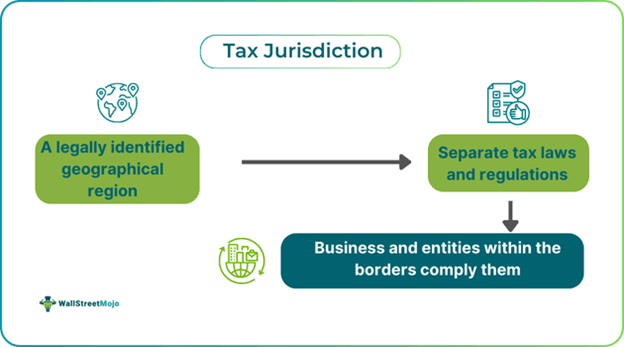Table of Contents
Tax Jurisdiction Meaning
A tax jurisdiction is a geographical area that has its own set of tax rules and regulations for all businesses and other entities operating within its borders. In the US, EU, and Canada, a jurisdiction can be a region, state, city, district, or province. These jurisdictions are complex, and businesses become answerable to different authorities and government levels.

Tax jurisdictions typically set their own rules about sales tax rates and which products or services are taxable, tax-free, or provided with zero-rated supply. They also set registration thresholds, filing procedures, frequency, and deadlines. A business operating within multiple jurisdictions may have to follow and comply with all those jurisdictions individually and collectively.
Key Takeaways
- Tax jurisdictions are geographical regions or legally identified areas that have written their own tax rules and regulations for every business that operates within their borders.
- The US has more than 12,000 tax jurisdictions based on state, county, district, and province, but the European Union has only 27, which signifies separate tax regimes for all 27 EU members.
- The US tax jurisdiction codes are composed of digits: three for a state, two for a county, four for a city, and again three for a district. The combination looks like a string of numbers.
- Many businesses try to find low-tax jurisdictions so that they do not have to deal with the complexity of tax laws and pay low taxes on their profits.
Tax Jurisdiction Explained
Tax jurisdictions refer to the set of tax laws and regulations defined for a specific region or geographical area. These jurisdictions represent various tax regimes that apply to anyone operating within their borders. In the United States, there are over twelve thousand sales tax jurisdictions, encompassing state, county, city, district, and local levels. Many people find the U.S. tax system challenging due to the numerous and frequently changing tax jurisdictions, making it complex and difficult to navigate.
In the US, sales tax is theoretically charged only once at the final product purchase, but it is not a nationwide policy. The United States does not have VAT like in the EU or GST in Australia. Sales tax exists at multiple levels, where state and local jurisdictions have the authority to set their tax rates and regulations. This is a prominent reason why many international businesses trading in the US struggle with tax compliance.
Tax liabilities in the US are classified as either in-state or out-of-state. The latter are online businesses that are also known as remote sellers. According to local and district-level tax jurisdictions in the US, 45 states and the District of Columbia collect statewide sales taxes. Still, Oregon, Montana, Alaska, New Hampshire, and Delaware do not have any sales tax at all. On the other hand, 38 states have local sales taxes. This whole setup results in complex US tax compliance.
US Tax Jurisdiction Codes
The United States authorities assign tax jurisdiction codes to specific jurisdictions that identify to which jurisdiction a particular business belongs in the country. They are typically composed using small codes, basically digits, to represent state, county, district, or province. In the US, tax jurisdiction codes are usually created in the following manner:
- Three digits representing the state
- Two digits signifying a county
- Four digits showcasing a city
- Three digits representing a district
When all of the digits are placed together, they form a string of numbers: state + county + city + district. The exact format and digits can vary based on the tax authority and jurisdiction structure. If an individual does not know about their jurisdiction code, they can check it online by visiting the state’s official website.
In addition, the US has zip codes, and each zip code signifies at least one or multiple tax jurisdictions. Still, it is advised not to use them to determine jurisdiction or tax liability as they primarily run parallel to postal service and are mainly designed for mail services.
Examples
Here are two distinct examples of tax jurisdiction. The first is hypothetical, but the second is from real-world news:
Example #1
Suppose Rachel starts a footwear company in New York. She follows the tax laws and regulations of both New York state and the federal government. Rachel has to answer multiple tax authorities, and the whole system is rigid for her. Once she visits Germany for a business trip and finds out that Germany has a low tax regime compared to the US, Rachel likes it so much that she immediately decides to shift her entire business to Germany.
By doing so, Rachel not only saved a lot of money in sales tax, registration and filing, but the entire tax jurisdiction was not as complex as it was in the US. Except in certain scenarios, businesses in Germany only face three different VAT rates: full rate, reduced rate, and a 0% rate for certain tax-relieved transactions. This example shows how tax jurisdictions are not universal and can change from one geographical location to another.
Example #2
For the second example, Brazil’s government issued an executive order in October 2024, implementing a minimum 15% tax on multinational corporations' profits. Brazil is a low-tax jurisdiction because it grants tax incentives to many multinational groups. Now, Brazil is all set to adopt the Global Anti-Base Erosion Rules (GloBe Rules).
This shift is essential for Brazil because the Brazilian government has already been seeking new revenue sources so that it can meet its fiscal targets and try to reduce its fiscal deficit to zero. The Brazilian officials said that their next move would be to fight against tax evasion. Because it is a low-tax jurisdiction, around 1000 companies in their region are paying less than 15%, but after this rule, they all will be subjected to the new rule.

